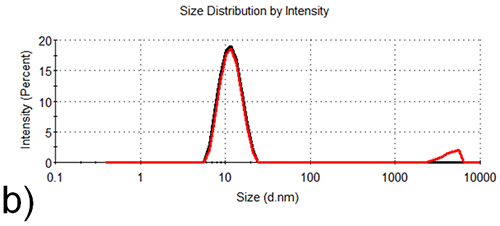The high sensitivity of dynamic light scattering (DLS) to protein aggregation explains the wide use of Zetasizer instruments within the biopharmaceutical industry. Since the amount of light scattered by a particle is proportional to size6, trace amounts of aggregate can be detected and sized using DLS. Conversely, this can make the measurement of native, monomeric protein in impure samples difficult, since the signal from large impurities may swamp that from the molecule of interest.
A detection angle of 173° (non-invasive back-scatter (NIBS)) reduces the obscuration of small molecules by large molecules, since, according to Mie theory, larger particles (specifically those with a diameter > 1/20 of the incident laser wavelength) scatter less light in the backward direction compared to the forward direction.
Nevertheless, the increased sensitivity of forward scatter optics to trace amounts of aggregate is often highly useful, with forward scatter (13°) measurements used alongside back-scatter measurements for enhanced detection of large protein aggregates. Zetasizer Nano ZSP and ZS instruments allow such dual angle measurements to be performed. Their application to an Immunoglobulin G (IgG) stability trial is described in this note.
A sample consisting of IgG in 50 mM arginine was prepared and filtered using a 20 nm pore size filter. An aliquot was removed and analyzed immediately after preparation, with the remainder of the sample then stored at room temperature. Further aliquots were removed and analyzed after 1 and 3 days of storage. Dual angle DLS measurements (173° and 13°) of automatic duration were carried out using a Zetasizer Nano ZSP.
The Aggregation Index is a parameter based on the mean z-average size measured for the two angles of scattering according to the equation:

|
Prior to storage of the IgG sample, DLS measurements acquired using both angles were highly similar (Figure 1). Following storage, 13° detection demonstrates the presence of aggregate that is not detected at 173°. This contrast between measurements made at 2 different angles can be assessed numerically using the aggregation index, which increases during storage (Table 1).

|

|

|
Malvern-patented non-invasive back-scatter (NIBS) optics widen the concentration range over which accurate DLS measurements can be made, in part by reducing the effect of large artifacts (such as dust) on DLS measurements. Nevertheless, for some applications (quality control of fully developed, pure biopharmaceutical samples for instance) the increased sensitivity of forward scatter optics to trace amounts of aggregate is highly useful. This note demonstrates the use of forward scatter and back-scatter DLS measurements together in order to follow aggregation processes that would not be fully characterized using one angle alone.
| Time point (days) | Aggregation Index |
|---|---|
| 0 | 0.0 |
| 1 | 0.1 |
| 3 | 0.5 |